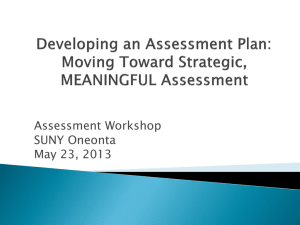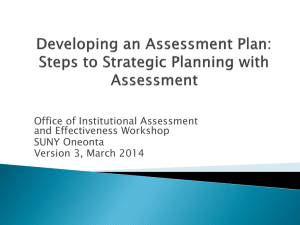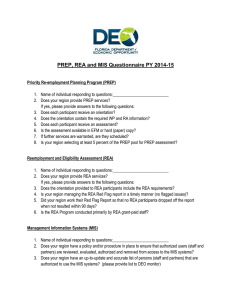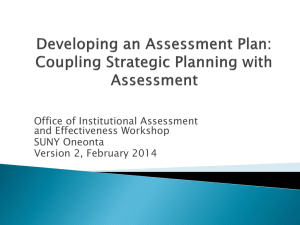Data Models of Accounting Information Systems
advertisement
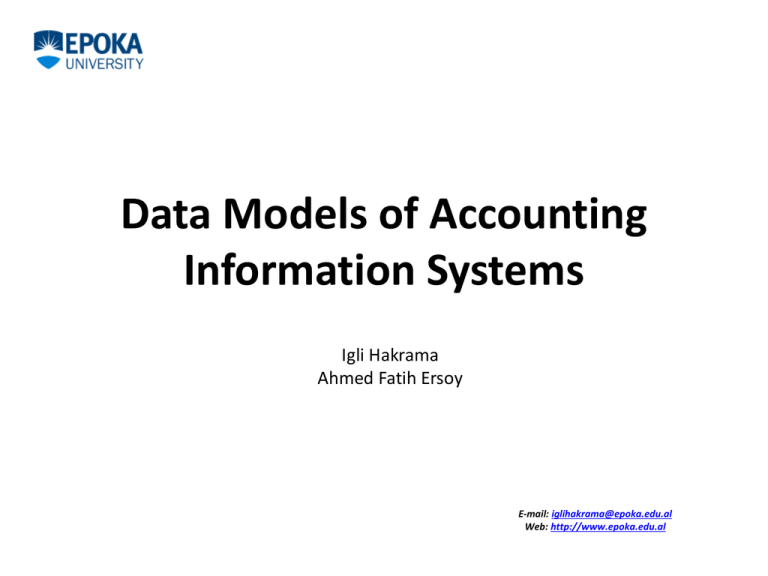
Data Models of Accounting Information Systems Igli Hakrama Ahmed Fatih Ersoy E-mail: iglihakrama@epoka.edu.al Web: http://www.epoka.edu.al General • The purpose of a data model is to describe logic structure of the object system, as it is looked by his users. • In Accounting Information Systems, the object is the economic entrepreneur and the information stored which is needed in a structural way so the data may be consistent and integrated. • Reality modeling of the components around the economic unit is very important for building an efficient system which stores the information about the economic unit. 2 AIS • The beginning of AIS modeling = materialization of economic unit => proccess. • Luca Pacioli during “Reinaissance” (same model) • Traditional Model • Beginning from the years 1975 until the beginning of 80 a number of changes happened in the field of data modelling in general and in the modelling of data in Accounting Information Systems. 3 REA Model • In 1979 William E. McCarthy on his thesis “An entity-Relationship View of Accounting Models” introduced a model which is now implemented in the most famous AIS and ERP. • His suppose was based on the postulate: “A AIS may be naturally simulated on an relational database which contains real world entity and relations between these entities”. • Importance can be given to the financial information system (e.g. ERP) which doesn’t have anything from traditional system. 4 REA Model • The procedure which is recommended to be taken while building an AIS model is: – Identification of classified entities in Agents, Events and Resources. – The building of an E-R diagram which will expose the meaning of these entities and relations between them. – Definition of entities characteristics and of the relationships between them, classified by the demands of the different level users. – Organization of results from the previous steps in the tables and identification of their unique characteristics (Keys). 5 REA Model • Information Identification and protection in this model is done by following these steps: – Event – Sources which are consumed or added by this event – Internal Agents – External Agents 6 7 REA Model • The main rules are: – Every Event is connected to at least one Source from which it differ – Every Event is connected to at least one other Event. – Every Event is connected to at least two Agents (The economic duality principle). 8 An Schematic presentation of the above rules for an process example. Basing on the REA cycles model of AIS, they would be presented in this way. 9 The REA Model spring up in a time where it was being talked about “reengineering” term which inclines the fundamental change of a process as the only way of his enhancement. REA presents the fundamental change in the data modeling of AIS, so it presents AIS itself. REA model is the base of all other models of AIS and there have been a lot of his versions, for example: REA-L – which adds the entity: Locations to the REA model, etc. McCarthy is being thanked in a lot of books about AIS as the person who had the courage to think different from the others. 10 IAC MODEL • This section describes a model with an alternate accounting data structure that radically eliminates the most pervasive and potentially inconsistent redundancies of the traditional administrative-accounting model. • The name IAC comes from the initials of Items, Agents, and Cash. • The IAC classification is a more normalized data structure that eliminates many of the redundancies present in the traditional model. 11 IAC MODEL • The IAC model consolidates customers, suppliers, employees, and stockholders into one entity: Agents. • The entity Item consolidates fixed assets, inventory, and all the goods and services that the company buys or sells including shares (stock). • The entity Cash consolidates bank accounts, petty cash, and any other account that reflects the flow of money. 12 IAC MODEL • Administrative and accounting systems register the economic activity of a company. • The Agent entity responds to the question of “Who” (surrenders or receives the goods or services); • Item responds to the question of “What” (goods or services); and • Cash to the “How much” (money it is given or received in exchange for the goods or services). • This way the three IAC entities cover all the entities involved in economic activity and therefore consolidates all of the accounts of an administrative or accounting system. 13 The Fundamental Accounting Equation under IAC • The Fundamental Equation of Accounting Assets = Liabilities + Capital • It may be transformed into a new one, which is equivalent with the first one. Account of Goods (Items) = Accounts of People (Agents) + Accounts of Money (Cash) • It may also be expressed in this way Σ Agent(ID, Amount) = Σ Item(AgentTransID=ID, Amount) + Σ Cash(AgentTransID=ID, Amount) 14 Conclusions • Why REA is still the best data model... – REA is a data model that everyone may use, it’s not “proprietary”. – REA Data Model may cover administration of multiple companies. – REA Data Model predicts all types of activities and relations between them in a uniform way. – REA Data Model manage all the sources: -products, money, work, enginery – in a consistent way. – REA Data Model can be built in an incremental way letting the modifications of the system and his expansion. • The IAC model is a model generally more advanced than REA, but his implementation is difficult for two reasons: – IAC is a proprietary model – CAUTUS NETWORKS CORPORATION – Lack of the detailed information – there exists only one published document from Prof. Carlos Ferran - Penn State University • The chances are that in some years IAC will be more efficent and more reliable. 15 Thank You e-mail: Web: iglihakrama@epoka.edu.al afersoy@epoka.edu.al http://www.epoka.edu.al Author: Igli Hakrama Ahmed Fatih Ersoy 16



